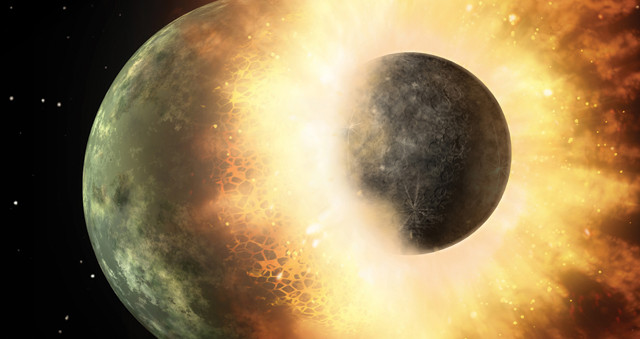
by Mary Caperton Morton Tuesday, July 3, 2018

An artist's rendering of the collision that could have created the moon. Credit: NASA/JPL-Caltech.
The moon is a child of catastrophe, born from a massive collision between the young proto-Earth and a Mars-sized object during the formation of the solar system. A new study looking at isotopes in both lunar and Earth rocks is refining the timing of this event and revealing new information about when Earth became a watery planet.
The isotopic ratios in most moon rocks closely match those found on Earth, meaning that the starting materials — the remnants of the proto-Earth and the mystery impactor — were well-mixed during and after the impact. The exception is oxygen-17, which varies by 3 to 4 parts per million in lunar rocks compared to terrestrial basalts. This slight difference may be explained by the timing of when early Earth got its water from icy meteorites, according to the new study in Science Advances.
The historically popular “late veneer” theory proposes that most of Earth’s water was delivered after the moon-forming impact. But if most of Earth’s water came after the moon’s formation, the oxygen isotopes would be markedly different from those measured. In the new study, Richard Greenwood of the Open University in England and colleagues offer an alternative model, suggesting that less than 30 percent of Earth’s water was delivered after the impact while the majority arrived before Earth and the moon split.
“Fortuitously for the evolution of life on our planet, despite the high energy of the moon-forming event, Earth retained enough of its primordial water to remain a habitable environment,” Greenwood and colleagues wrote. This scenario may also have implications for the search for life on other water-bearing planets: “Retention of early accreted water on Earth may have more general implications for the habitability of exoplanetary systems, which commonly experience similar early-stage, high-energy collisional processing.”
© 2008-2021. All rights reserved. Any copying, redistribution or retransmission of any of the contents of this service without the expressed written permission of the American Geosciences Institute is expressly prohibited. Click here for all copyright requests.